Photo Essay: Santa Barbara’s Bungalow Haven and Amazing County Court House
by David Kramer 3 CommentsWith its rich history and sunny Mediterranean climate, Santa Barbara has been an immensely popular destination since being settled by Spanish Missionaries in the late 1700’s. Following its annexation by the United States in 1846 after the Mexican-American War, Santa Barbara quickly expanded. Through the mid and late 1800’s, the city was home to countless pioneers who moved west in search of gold, but the big population boom happened just before the turn of the 20th century when oil was discovered in the area.
In the first 30 years of the 20th century, Santa Barbara’s population multiplied by more than 5 times – growing from approximately 6,500 in 1900 to over 33,000 in 1930. It was during this time that most of the town’s extensive collection of bungalows were built. Bungalows can be found in nearly every neighborhood of Santa Barbara, but none exhibits a greater concentration of bungalows than the appropriately named Bungalow Haven.
Located in the Lower Riviera District, bound by Laguna Street to the west and E Victoria Street to the south, the Bungalow Haven Neighborhood Association was organized by a group of like-minded homeowners who “share a sense of community with one another and appreciate the City of Santa Barbara’s unique architectural history.”
Every block of Bungalow Haven is loaded with bungalows of all shapes and styles – most are a modest size, not too extravagant, and exhibit the design features you’d expect to see in hand-built homes of this era. Below is a sampling of typical homes in the neighborhood…

Located a few blocks to the north and west of Bungalow Haven is a home that is perhaps one of Santa Barbara’s best examples of craftsman architecture, and not surprisingly, it was designed by Greene & Greene. The Nathan Bentz House (below) was designed by the brothers in 1911 and built by local contractor Isaac Hardy for a mere $5000.
Bentz (pictured below on the steps of his home) was a well-known art dealer who specialized in Japanese and Chinese antiquities. He was one of the first American importer/exporters of Asian artifacts and sold to many prominent and wealthy clients throughout the United States and Europe. Nathan’s brother, John who was also an art dealer, had commissioned the Greenes in 1901 to design a retail building, and later in 1906, his own personal residence in Pasadena. Nathan was fond of the home they designed for his brother and was enamored with the Greenes use of Asian elements in their designs. Bentz lived in the home from when it was completed in 1911 until his death in 1943.
In the blocks immediately surrounding the Bentz House are more bungalows (below) that sit on slightly larger lots than their brethren in Bungalow Haven. Consequently, these homes tend to be more grand, with many, like the Bentz House, having impressive vistas of downtown Santa Barbara, the Pacific Ocean, and the Channel Islands offshore.
Back in downtown Santa Barbara stands a building (below) that’s been referred to by many as “one of the most beautiful government buildings in America.” The Santa Barbara County Courthouse that exists today was designed by William Mosier III and completed in 1929, but it actually replaced the original courthouse, built in the 1870’s, that was all but destroyed by a devastating earthquake in June of 1925.
The building was the embodiment of the Spanish-Moorish style that was adopted by city planners after the earthquake. The style was wildly popular and reflected the region’s Spanish heritage. The building’s signature feature is the clock tower, known as “El Mirador” (above), which affords 360 degree views from the mountains to the sea, and beyond.
Inside are arched doorways, Moroccan style lighting, and colorful hand-painted tiles that complete the authentic look. Underneath arches and coffered ceilings (below), long hallways span the length of the building, while natural light pours in from the courtyard.
Stairways at opposite ends of the building (above) lead up to the second floor where the crown jewel of the courthouse, the Mural Room (below) can be found. Depicting several different scenes from Santa Barbara’s long history, the murals cover over 6,000 square feet of wall-space and were painted by native Californian, Daniel Sayre Groesbeck. For an amazing 360 degree virtual tour of the Mural Room, be sure to check out this link.
From the 4th floor, there is one more set of stairs that you must climb in order to reach the top of the clock tower. The view from the top (below) is amazing on a clear sunny day.
Santa Barbara’s year-round sunshine, laid-back vibe, and beautiful scenery make it one of my favorite places in all of California, and the fact that there’s also a wealth of turn-of-the-century architecture is definitely an added bonus. If you’ve been to LA and San Francisco and are looking for something a little different from both of them, you can’t go wrong in Santa Barbara. And for the ultimate California experience, I’d highly suggest making the drive from San Francisco all the way down the coast to LA. Then you’ll be able to enjoy not only the rustic beauty of the Pacific Coast Highway itself, but also the seaside artist community of Carmel, as well as The Hearst Castle and San Luis Obispo, before reaching Santa Barbara!
Enjoy!



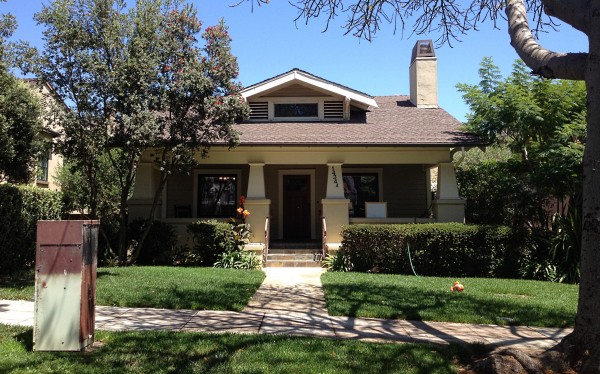



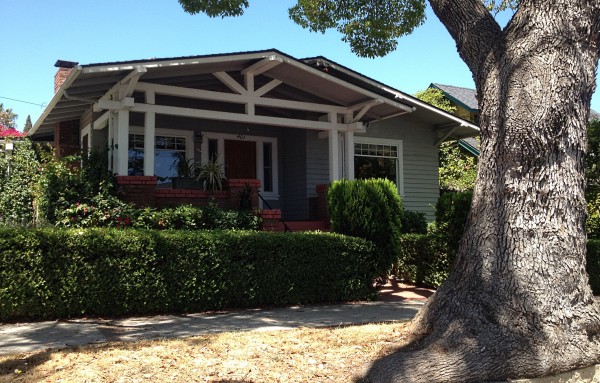


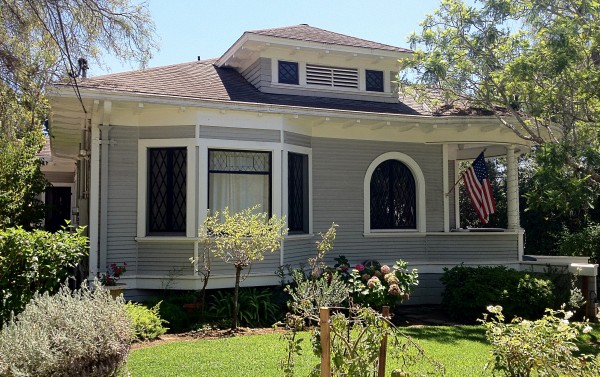


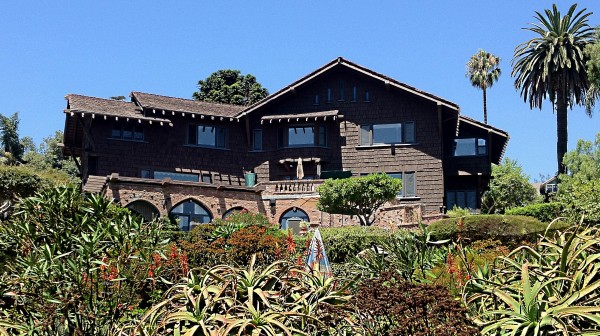
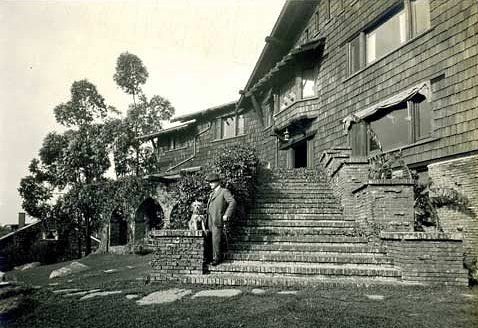


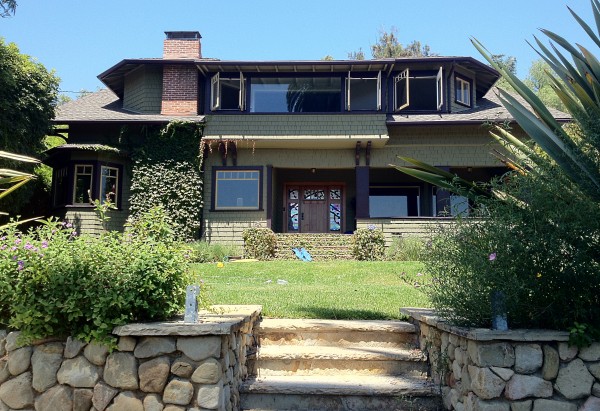

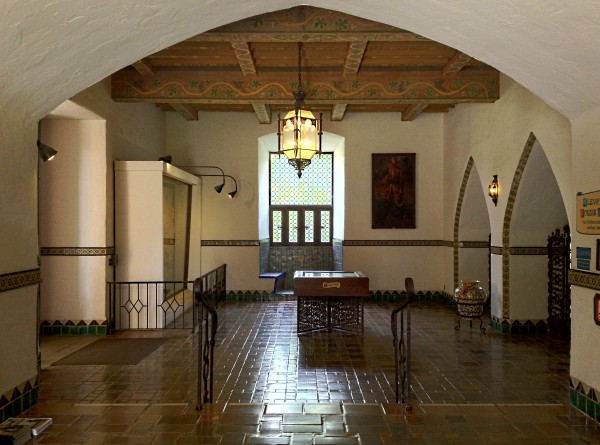








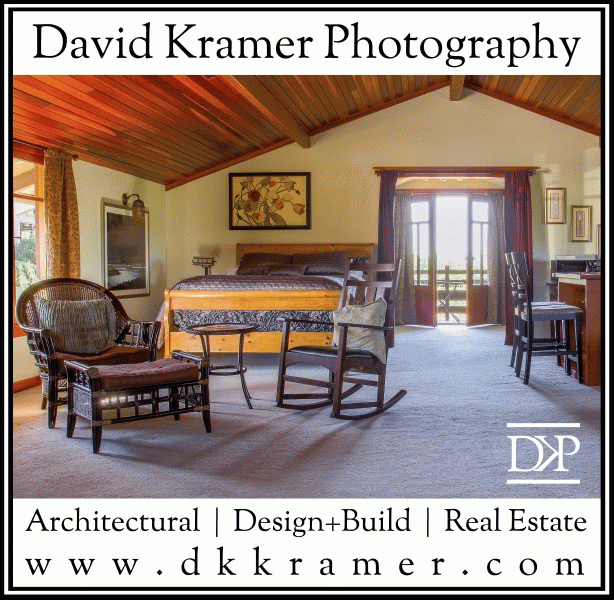



3 comments
Tom Shaw says:
May 17, 2013
Great article David! I love how you were able to get close enough to sneak a picture of the Nathan Bentz house similar to the old photo. Looks like they got rid of the snaky roof drain pipe on the left, which is an improvement. The dog is cute though.
Does the City of Santa Barbara still require that new and existing buildings in the core use red tile roofs and white stucco walls? Also, if I remember correctly, the building height in the core was limited to below the top of the city hall tower.
-Tom Shaw
The Craftsman Bungalow says:
May 18, 2013
Thanks Tom and good to hear from you! Not sure about the red tile roof and building height code, but it would make sense. I have a friend who lives there and is trying to put an addition on to their house and the City is real particular about everything…
Tom Shaw says:
May 19, 2013
The Craftsman Bungalow David, I sent some photos to your private email account. They may have wound up in your spam box.